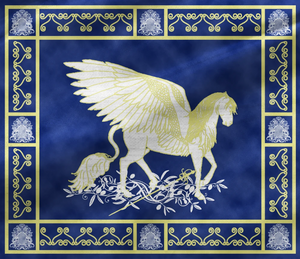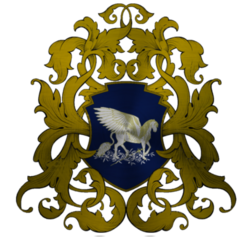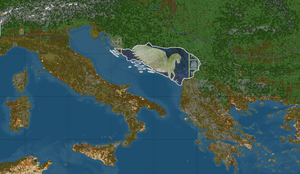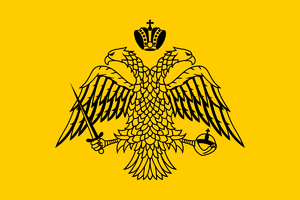Aurora:Ragusa
The Crown Republic of Ragusa, more commonly referred to as Ragusa and The Republic, is a trade Republic located on the coast of the Adriatic between Epirus, The Kingdom of Serbia and Venice. Whilst appearing to act as a city state, the Republic is a parent to other trade city-states such as Trebizond - a costal town located on the shore of the Black Sea.
| ||||||||||||||||||||||||||||||||||||||||
History
April 19th, 2022: Terra Aurora Announced
On April 12th, 2022, the MOTD on the EarthMC Minecraft Server was changed to a set of coordinates encoded into base 64. Going to those coordinates, players would find a message quoting a YouTube comment made by Fix on the EarthMC: Terra Nova update teaser video. Rumour begun to spread across the server of a reset, with countless catholic states including the Vatican, France, and SPQR proclaiming the end of days.
In Tyre, the capital of Terra Novas Carthage, the people sat idly and watched from the shores of the Mediterranean as the people of Europe rallied for a new effort - for here, as in Numidia and the rest of Africa, the mood was solemn. It was not till April 19th, 2022, when Fix announced on the EarthMC Discord that the upcoming release shall me named Terra Aurora - thus confirming the rumours.
April 21st, 2022 and Launch: Creating The Republic
With the confirmation of the reset, the members of the Pax Africana - a collection of independent African states from Terra Nova - begun discussing their plans. Whilst many moved to new locations across the map, members of the Carthaginian and Numidian states decided to come together and form a unique trade republic based on their shared values and experiences.
When the server finally opened the extensive planning, cultural development, and amassing of dedicated Dalmatians, ensured that the capital of Dubrovnik would be founded within the first crucial hours. As others raced to form nations, the people of Dubrovnik begun expanding their borders and building the key essentials that would ensure their perpetual presence and domination of the region; focusing particularly on their loyalty to the Orthodox faith and strong culture.
May 3rd, 2022 and Launch: Ragusa as a Metropolis & The Personal Union
With the creation of Dubrovnik came the influx of individuals seeking shelter and good will, both of which are always offered to all passing through regardless of state or status. As the community grew so did the presence of ambitious nobles who strived to cement themselves and expand the Mercantile, Orthodox, and Liberal ethics of The Republic across the region. With such ambition the first to seek funding was PastelAnt387850, who settled the Polis of Trebizond on the northern coast of Anatolian. Whilst such success is limited there have been many seeking support from The Republic.
Yet, as the virtue and goodwill of The Republic became noticeable in the region, so did its power with many states seeking to extend an alliance towards its people. The Kingdom of Serbia - formerly regarded as The Kingdom of Yugoslavia - in particular took to The Republic, admiring its cooperation in a time of uncertainty and brutal politics. Over the coming days a stable and favourable alliance was stricken, with a personal union forming between the two states as to seal the deal and begin the spread of the Orthodox faith throughout the region.
Geography, Territory & Architecture
The city of Dubrovnik is located on the Adriatic coast of what is in real life the south tip of Croatia. To its south is the capital of Epirus, Appollina, whilst to the north east is the capital of The Kingdom of Serbia, Belgrade. Heading north are the towns of Aurora and Zagreb, alongside the capital of Venice, Venice. Across the Adriatic are the towns of Rome and Naples, key founders of the Papel states, whilst northern Italy is populated by innumerable towns such as Monaco, Genoa, Veneto and Florence.
The lands of The Republic have been agreed upon by all key players within the Adriatic basin and the Balkan region. As of May 5th, 2022, The Republic lays claim to what is considered part of in real life Montenegro, alongside a large proportion of costal Croatia, and southern Bosnia-Herzegovina.
Throughout the city-state nation you will find a mix of the baroque style, with Greco-Roman and Middle Eastern inspirations. The famous EMC docks of Ragusa embrace a brick style façade with Mediterranean decoration embracing the style of the Greeks, Romans and Phoenicians. Atop there is a wide street open market surrounded by beautifully carved housing, with churches, shops, museums, and gardens adding to the life.
Government
The Republics government is full sovereign and acts upon its own accord rather than abiding by the demands and intentions of foreign powers. Thus the government exists to pass legislation and make decisions that protect the freedom of the state.
The Kaeseras
The Kaeseras is the highest position within The Republic and is the equivalent of a monarch. Whilst most monarchies across the continent act in a hereditary manner, The Republic seeks to preserve the principle of democracy and liberties, thus upon the departure of the existing Kaeseras an election shall be held within the Parlamento (Parliament) between the relevant candidates. Should there be more than two candidates for the tron then are two rounds of voting, the first between multiple candidates and the second between the two victors of the first round.
In accordance to the liberal ideology of The Republic, the position of Kaeseras is constrained and is mostly ceremonial. They act as an international representative and delegate of The Republic, focusing largely upon negotiations, and deepening ties with other states. Alongside this, the Kaeseras approves legislation and projects passed by the Parlimento and the Boule, as well as bringing any issues to them to address across The Republic and its subsidiaries.
The Parlamento and Boule
The Parlamento consists of high-ranking aristocrats called the Consigli; heads of influential noble houses that have amassed respect, recognition, and wealth, and who have contributed to the development of The Republic in a significant manner - whether that be through funds, architecture, politics, culture, or military achievements. The Parliamento shall develop and pass any necessary laws and projects, whilst also representing the interests of the people, as well as following up upon issues presented to them by the Kaeseras.
The Boule consists of four appointed positions: The Boulus Stratigós (Head of Military), Boulus Steward (Head of internal affairs and development), Boulus Patrijarh (Ecumenical Patriarch of the Orthodox Faith), and the Boulus Cancelliere (Head of the economy and infrustructure). These four individuals are elected by the members of the Parlimento and they manage the implementation of legislation, as well as the day to day affairs of The Republic alongside the Kaeseras. These positions are elected every 31 days, and similar to the election of the Kaeseras should there be more than one candidate the election for the position is split into two rounds - the first between the selection and the second between the two highest scoring candidates.
The Judicii
The Judicii acts as the chief court of law within The Republic and consists of an Arch Ludex (The Permenant overseer of the court of law) and four Mikrós Ludex’s (Randomly selected members of the nation who act similar to a jury) who hear and determine the sentences and punishments placed on criminals. They are expected to be unbiased and cannot be influenced by the Parliamento, nor the Kaeseras. To ensure this they receive a set payment that cannot be reduced nor increased without the consent of the Kaeseras, and Parlimento, and all four of the Mikrós Ludex must be selected randomly by the Arch Ludex and must be present at a trial - the outcome of which will be decided by a simple majority e.g. 3-2, 4-1, or 5-0.
Members of the Judicii should be selected from all three of the classes.
The Milizia
Whilst remaining typically pacifist due to its denunciation of the glory of war that so many nations speak , The Republic keeps a well-skilled and active military branch known as the Milizia. The members of the Terra Milizia are led by the Stratigós and act as both the city guards and official military force as their intentions to protect the integrity and independence of the Republic from the clutches of authoritarianism, hatred, and crime often overlap the two areas. Members of the Nero Milizia are led by the Navigós (A position typically held by the Stratigós as well) and oversee that water laws passed by the city are adhered to, that all goods traveling through the city are safe and declared, and during times of war they manage the Ragusan fleet.
Culture
Whilst The Republic inherits much of its cultural traits from the Latins, its society has undergone a period of renaissance following its independence and mass intake of new players - re-enforcing many of the traditions and aspects of its once abandoned culture, whilst adopting new Slavic and Greek customs. This new mix is what sets the Dalmatian culture apart from those of its neigbours, with an emphasis upon vibrant colour, often reflecting the surrounding landscape, high diversity and personal liberalisation. Tradition and culture are upheld by the people, and their interest in the high artistry, culinary arts, and grand architecture also define the set culture. Citizens enjoy free academic classes, theatre performances funded by the Upper Class, and local art, literature and museums can be experienced by any man, woman, or child.
The Republic is visibly a diverse place with people living all across its lands. Individuals who reside outside the city walls are referred to as Rustics Dalmatians and are known to be hard workers and are diligent when times call for it, however their joy of life, rustic nature and disinterests in flexing vast amounts of wealth can often undermine this perception. In contrast those who live within the city often adopt a Novus Dalmatian identity, a branch of the culture which shares the former's joy of life and nature, but places immense admiration for finer things in life such as jewellery, fine silks and beautiful architecture. Yet both are willing to stand up against corruption and the disrupt to their civil liberties should it be encroached upon by an internal or external force.
The culture of The Republic is also evidenced throughout its architecture and layout. The city - consisting of buildings inspired by the long forgotten Roman era, whilst incorporating in the Slavic and Greek identity - holds splendid grandeur and colour as pristine streets navigate through the city. Yet faced by the trouble of the terrain, many buildings are entered in through beautifully sculpted archways embedded into the mountains as they provide an entrance into the glistening halls that wind throughout them. In contrast rustic brick homes lay alongside the golden fields of wheat outside the city walls. Colourful merchant houses of many stories lay imbedded into the mountains, whilst the immaculately carved walls of the city house towering white structures and temples with deep blue domed roofs - a reflection of the achievements obtained through cooperation.
Social Structure
Like any well rooted society, The Republic has a mix of individuals in different social classes. Each individual seeking to create their own noble house may do so upon arrival - or they may equally join an existing one and help grow it until they are ready to split off and form their own.
Regardless of this, there are some set social structures in place which may be found below:
The Rustics (The Exopolikós)
The Exopolikós (More commonly referred to as the Rustics) are often farmers, tavern owners and craftsmen/ craftswomen who live outside the city walls. Unlike the rest of The Republics societies women typically wear a long flowing skirt with a loosely fit top paired with a handkerchief or sting to keep their hair up so that they can do their tasks with ease. Men - whilst chasing to remain more reserved in colour - typically dawn a loose tunic or shirt and faded waistcoat in the neutral or highly worn bright colour, they often wear loosely fitting trousers although unlike the waistcoat refrain from the brighter pallet often being brown, black or grey instead. Both sexes don’t wear any jewelry unless it’s from leather or iron.
Politically the Ecpolikós tend to refrain from being active, preferring to focus upon the art of crafts, farming, construction and as such. Most people coming to The Republic enter at this level and work their way up to higher levels in society through work for gold, as well as developing an identity for themselves.
The Maestros (The Intrapolikós)
The Intrapolikós (More commonly referred to as the Maestros) are individuals skilled in trade and mercantilism, the high arts, high regarded researchers, and individuals of a similar kind or equal wealth. They live within the city walls. Women within this class don a mix of vibrant colours from all the spectrums and wear silver or cheap gold jewellery although in minimal amounts. Most women chose to wear their hair down and leave it uncovered due to the lack of intense labour. Men, similar to their female counterparts, tend to wear more vibrant colours with a blazer accompanying their waistcoat. Their trousers - whilst remaining in the dark colour pallet - are more tailored and fitted as are their shoes.
It is the Maestros who are often breaking the ground of politics and begin their career in it. Whilst typically not in the Parlimento, members of the Maestro class will help develop the community through engaging independent projects and grow their portifolio. Some members of the class will feature in the Parliamento simply due to their preference to stay in it but their noteworthy achievements has allowed them to secure a comfortable spot.
The Patricians (The Archpolikós)
The Archpolikós (More commonly referred to as the Patricians) are a small group of individuals from the most ancient families of The Republic, who reside within the most prestigious part of the city. Women of the class often wear simple pristine white robes as a display of charitability and contentment, with their high ranking level often being represented by the vast amount of real gold jewellery and gems that they wear. Some aspects of vibrant cloth may be incorporated into their dress however this is often rare. Men of the class wear well tailored clothes which are vibrant, although many often wear more reserved colours as a display of authority and seriousness due to their high ranking positions. They may also don capes although this is not as common as it is in the Intrapolikós class.
It is these individuals who traditionally make up the majority of the Parlimento, and who hold the most senior positions within the Boule, Milizia and Orthodox Church.
The Orthodox Church
The Orthodox faith plays a crucial role in The Republic, adding the unifying force under one church alongside the one political banner. Citizens, whilst able to practice their religion freely, are strongly encouraged to partake in the Orthodox ceremonies and practices. The Boulus Patrijarh acts as the Ecumenical Patriarch of the Orthodox Faith with the city of Dubrovnik acting as the home of the Orthodox Faith on EarthMC: Terra Nova. There are several dioceses outside Dubrovnik including those of Sofia and Sarajevo, with one of the older ones being the Diocese of St. Eugenios of the Grey Minthrion in Trebizond.
Additional Information
Diplomatic Relations
As of May 5th, 2020, The Republic holds the following as allies: Kaiserreich, Yugoslavian Socialist Macedonia, Savoia, Epirus, Serena Repubblica di Pisa, Egypt Empire, New Galicia, Spain/ Castile, China, Carthage, Regnum Hungaricum, Switzerland
As of May 5th, 2020, The Republic holds the following as Neutral: Republic of Venice, Brazil, France, Germany, Castille/ Spain, Portugal, The Papal States, Pakistan, Japan, Victoria, Australia, Aotearoa, Madagascar, Mali, California, Caribbean, Argentina, Bokkai, Indochina, Khazar
As of May 5th, 2020, The Republic holds the following as Enemies:
National Subdivisions
As of May 5th, 2020, the following towns make up The Republic: Dubrovnic
As of May 5th, 2020, the following towns make up The Republic's trade-polis: Trebizond



